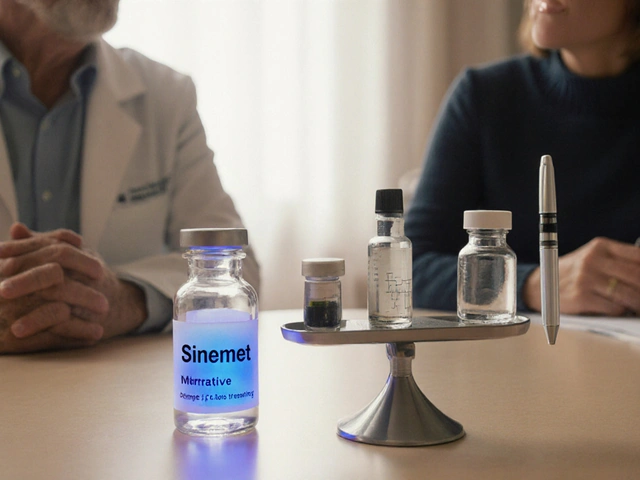If you’re allergic to penicillin, you might wonder whether you can safely take cefprozil. The short answer is: it depends on the type of allergy, the severity of past reactions, and the specific cephalosporin you’re considering. This guide walks you through everything you need to know about cefprozil, penicillin allergy, and how doctors decide if the two can coexist.
What is Cefprozil?
Cefprozil is a second‑generation cephalosporin antibiotic that targets a broad range of Gram‑positive and some Gram‑negative bacteria. It’s commonly prescribed for sinus infections, skin infections, and uncomplicated respiratory tract infections. Cefprozil works by inhibiting bacterial cell‑wall synthesis, a mechanism it shares with the broader beta‑lactam class.
Understanding Penicillin Allergy
Penicillin is the prototypical beta‑lactam antibiotic that has been in use since the 1940s. An allergy to penicillin can manifest in a few ways:
- IgE‑mediated hypersensitivity (hives, swelling, anaphylaxis)
- Delayed maculopapular rash (often appears days after exposure)
- Serum sickness-like reactions (fever, joint pain, rash)
Approximately 10 % of the population reports a penicillin allergy, but detailed testing shows that only about 1 % have a true IgE‑mediated response.
Beta‑Lactam Cross‑Reactvity: The Core Issue
Both penicillins and cephalosporins belong to the beta‑lactam family, which means they share a four‑membered beta‑lactam ring. Historically, doctors assumed a high cross‑reactivity rate (up to 10 %). Modern studies, however, show that the risk is much lower and largely depends on the side‑chain structures.
For cefprozil, the side‑chain differs significantly from penicillin’s, dropping the overall cross‑reactivity to roughly 1 % for patients with confirmed IgE‑mediated penicillin allergy. This figure rises slightly for cephalosporins with similar side chains, such as cefaclor.
How Doctors Assess the Risk
- Take a detailed history. Timing, type of reaction, and severity guide the next steps.
- Perform skin testing. Penicillin skin testing (using major and minor determinants) identifies IgE‑mediated sensitivity.
- Consider graded oral challenge. If skin testing is negative, a supervised dose of cefprozil can confirm tolerance.
- Review alternative antibiotics. When uncertainty remains, clinicians may choose non‑beta‑lactams, such as azithromycin or doxycycline.
Skin testing for cephalosporins is less standardized, so most protocols focus on penicillin testing first, then infer risk based on structural similarity.

Comparative Cross‑Reactvity Table
| Cephalosporin | Side‑chain similarity to penicillin | Reported cross‑reactivity |
|---|---|---|
| Cefprozil | Low | ≈ 1 % |
| Cefaclor | Moderate | ≈ 5 % |
| Cefuroxime | Low | ≈ 2 % |
| Cefotaxime | Very low | ≤ 1 % |
| Cefepime | Very low | ≤ 1 % |
When Cefprozil Is Considered Safe
If a patient’s penicillin allergy was limited to a mild rash without systemic involvement, most clinicians feel comfortable prescribing cefprozil after a negative skin test. Even in cases of prior anaphylaxis, a negative skin test plus an observed graded challenge can safely clear the way for cefprozil use.
Key safety tips:
- Always document the nature of the original penicillin reaction.
- Choose the lowest effective dose of cefprozil and monitor for 30 minutes post‑administration.
- Educate patients on signs of delayed reactions (e.g., rash appearing days later).
- Consider pre‑medication with antihistamines only if the history suggests a borderline IgE response.
Alternative Antibiotics for Penicillin‑Allergic Patients
When uncertainty remains, or when a patient requires a beta‑lactam‑free regimen, doctors turn to macrolides, tetracyclines, or fluoroquinolones. Below is a quick rundown:
| Drug class | Typical indication | Key considerations |
|---|---|---|
| Azithromycin (macrolide) | Respiratory, skin infections | Good tolerability; watch for QT prolongation |
| Doxycycline (tetracycline) | Community‑acquired pneumonia, acne | Contraindicated in pregnancy, children <12 |
| Levofloxacin (fluoroquinolone) | Complicated UTIs, severe sinusitis | Risk of tendon rupture; reserve for serious cases |

Practical Checklist for Patients and Providers
- Confirm allergy type: IgE‑mediated vs. non‑IgE.
- Review past records: Look for documented skin testing results.
- Consider skin testing: Especially if the reaction was severe.
- Start with a graded oral challenge: Usually 1 mg/kg followed by full dose after 30 minutes.
- Monitor for 24 hours: Watch for delayed rash or systemic symptoms.
- Document outcome: Update allergy list to reflect tolerance or confirmed hypersensitivity.
Frequently Asked Questions
Can I take cefprozil if I had a mild rash from penicillin?
Yes, most clinicians will proceed after a negative penicillin skin test and a short‑term observation period. The risk of a serious reaction is under 1 %.
What if my penicillin allergy was anaphylaxis?
A negative skin test followed by a supervised graded challenge can still allow cefprozil use. However, many providers prefer a non‑beta‑lactam in such high‑risk cases.
Is there a simple blood test for penicillin allergy?
Specific IgE blood tests exist but are less sensitive than skin testing. They are useful when skin testing is not feasible.
Can I self‑administer a cefprozil challenge at home?
No. Graded challenges should be done in a medical setting where emergency medication is available.
What are the most common side effects of cefprozil?
Mild gastrointestinal upset, headache, and occasional rash. Severe allergic reactions are rare but require immediate medical attention.
Bottom Line
Penicillin allergy does not automatically rule out cefprozil. By confirming the allergy type, using skin testing, and possibly performing a graded challenge, most patients can safely benefit from cefprozil’s convenient dosing and broad coverage. When in doubt, non‑beta‑lactam alternatives like azithromycin provide an effective backup.
Always discuss your full allergy history with your healthcare provider before starting any new antibiotic. Proper assessment protects you from both under‑treating an infection and over‑reacting to a drug that’s actually safe for you.







Edward Brown
25 October, 2025 20:36 PMThink about the hidden agenda behind every label on a bottle. They want you to believe that a tiny side‑chain decides your fate, but it's just a smokescreen to keep you compliant.
Justin Scherer
25 October, 2025 21:59 PMThanks for breaking down the cross‑reactivity numbers. It’s good to know that a low‑risk cephalosporin like cefprozil can be an option after proper testing.
Cheyanne Moxley
25 October, 2025 23:06 PMHonestly, if you’re still scared of a rash you probably shouldn’t be taking any antibiotics at all. The system loves to label you allergic and then hand you a stronger drug.
Kevin Stratton
25 October, 2025 23:56 PMInteresting take, makes me think about how we define “allergy” in modern medicine 😊
Megan Dicochea
26 October, 2025 00:37 AMI appreciate the clear steps doctors use to assess risk, especially the skin test before a graded challenge. It really puts patients at ease.
Jennie Smith
26 October, 2025 01:11 AMExactly! And for those who are nervous, a calm explanation can turn the whole process from terrifying to manageable.
Anurag Ranjan
26 October, 2025 01:36 AMIn practice, I always verify the original reaction before prescribing any beta‑lactam, because details matter more than the generic label.
James Doyle
26 October, 2025 01:56 AMThe pharmacodynamic profile of cefprozil underscores its utility beyond superficial infections.
Its affinity for penicillin‑binding proteins is distinct, reducing immunogenic cross‑reactivity.
Clinical guidelines now prioritize structural analysis over blanket avoidance.
When a patient presents with a documented IgE‑mediated penicillin reaction, the first step remains thorough history taking.
Subsequent skin testing with major and minor determinants provides a quantifiable risk metric.
A negative result should not be a blanket green light; a graded oral challenge confirms tolerability.
During the challenge, dosing increments are calibrated to monitor for any emergent urticaria or anaphylaxis.
Monitoring extends 30 minutes post‑administration, but delayed maculopapular eruptions can manifest days later.
Thus, documentation of both immediate and delayed responses is mandatory.
From a microbiological standpoint, cefprozil’s spectrum covers streptococci and staphylococci effectively.
Its pharmacokinetics allow twice‑daily dosing, enhancing patient compliance.
Adverse effect profiles are generally mild, with gastrointestinal upset being most common.
Importantly, the low cross‑reactivity rate (~1 %) should inform, not dictate, prescribing practices.
Physicians must balance evidence‑based risk with individual patient history.
Ultimately, a nuanced approach mitigates allergy‑related morbidity while preserving therapeutic efficacy.
In summary, cefprozil can be safely employed in selected penicillin‑allergic patients when protocolled assessment is performed.
Melody Barton
26 October, 2025 02:14 AMWhile the jargon is impressive, the takeaway is simple: verify, test, then decide. Overcomplicating won’t help the patient.
Greg Galivan
26 October, 2025 02:31 AMYour so-called “studies” are just cherry picked data-real world safety matters more.
ALBERT HENDERSHOT JR.
26 October, 2025 02:46 AMRespectfully, rigorous trials provide the evidence we need, and dismissing them undermines patient trust.
Kala Rani
26 October, 2025 02:59 AMBut what if the whole cross‑reactivity concept is a myth? Maybe we’re all just scared of a harmless molecule.
Donal Hinely
26 October, 2025 03:11 AMYo, enough with the fear‑mongering-people need clear options, not endless warnings.
christine badilla
26 October, 2025 03:21 AMOMG, I feel the drama! It’s like the medical world is a soap opera, and we’re just the audience waiting for the next plot twist.